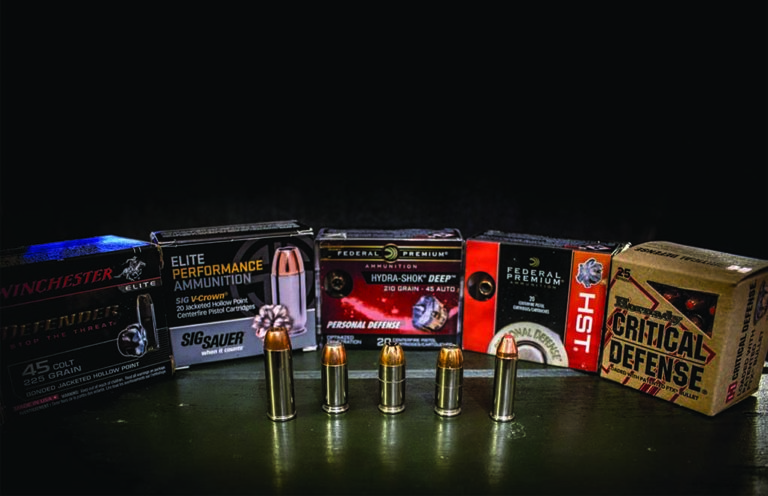

Build a better understanding of the terminal performance of defensive bullets and you'll find the one that will save your life.
What You Want In A Defensive Bullet:
- One that penetrates deep, but does not pass through.
- Expansion should be consistant at the typical defensive distances.
- The bullet should retain nearly all its mass, ensuring a larger wound channel throughout its path.
- Heavy clothing should not inhibt its performance.
Should you ever have the need to draw your defensive handgun in order to save your own life or the life of a loved one, I hope you have the best ammunition possible in the gun. No matter how expensive the handgun, no matter how ornate the scroll engraving and no matter how fancy the color case-hardening, it’s the bullet—and the bullet’s placement—that will make the difference of whether the threat is neutralized.
With a few exceptions, the tale of the modern handgun bullet has many parallels to that of the rifle bullet, but both share the benefits of the recent improvements in projectile design. Being completely honest, with the exception of the huge hunting cartridges such as the .460 and .500 Smith & Wesson, there really haven’t been any radical changes in defensive handgun cartridges in decades.
Perhaps that’s not necessarily a bad thing, because the top two—the .45 ACP and 9mm Luger—have been with us since the first decade of the 20th century and most certainly get the job done. Yes, the big 10mm Auto and .44 Remington Magnum are both stout and effective, as is the .357 Magnum, but the .40 Smith & Wesson falls in line with the .45 and 9mm.
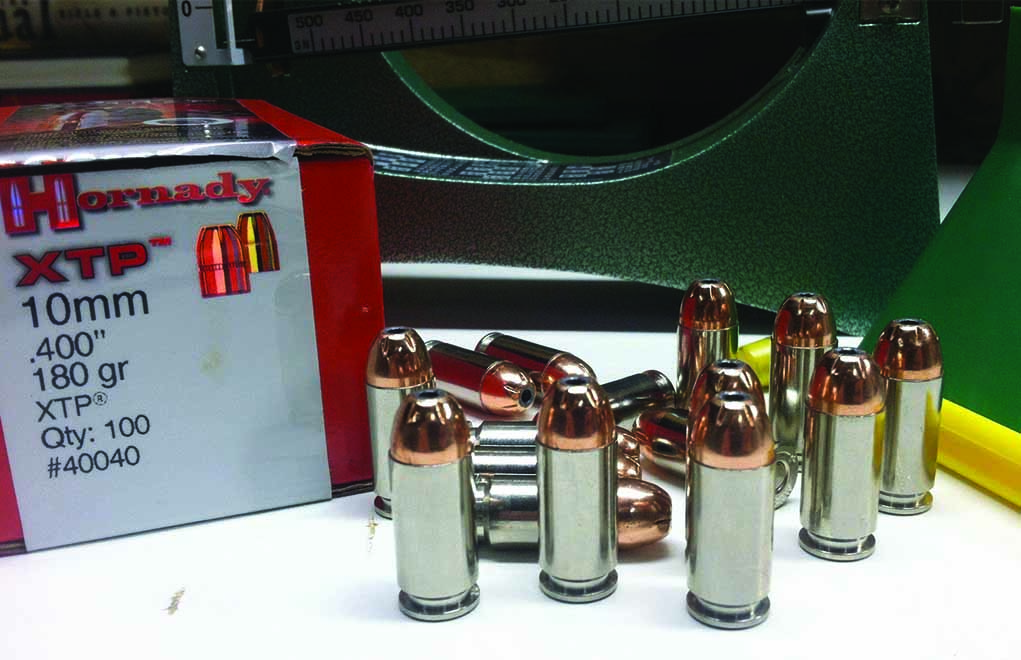
As long as we’ve had the modern metallic cartridge, we’ve had the lead projectile. It makes perfect sense, especially considering the era: The 1870s were years of expansion and exploration, with the Indian Wars raging and the Old West in full swing. While those proficient with the cap-and-ball pistols were certainly no strangers to casting their own bullets, the early .44-40 and .45 Colt cartridges could easily be reloaded with the molds and dies provided with the handguns.
Quite obviously, the long list of lives cut short by a lead bullet could be considered a testament to the integrity of the lead pistol bullet, but there are most definitely improvements on the design. Let’s take a look at the cross-section of defensive bullets available, what makes them tick and then put the designs up against one another for comparison.
Expansion and Penetration: Just the Right Amounts
Ultimately, what we’re after in a defensive projectile is the consummate blend of expansion and penetration. We don’t want too much penetration—as you can get from a full metal jacket or other non-expanding design—because of pass-through. Nor do we want too little penetration—as in a bullet that prematurely expands and fails to penetrate enough to stop the threat.

In the past, the poor penetration of lead bullets has been shown. In 1912, while seeking a third presidential term, Theodore Roosevelt was saved (thankfully) from an assassin’s bullet when it struck his eyeglasses case and the paper manuscript of the speech he was about to deliver. Had that been a bullet of modern design, history would’ve been rewritten in that instant. Fired from a distance of 5 feet, the .38-caliber bullet stopped short of Roosevelt’s lung, being slowed by 50 folded sheets of paper and that glasses case. (By the way, he delivered his speech—in spite of the gunshot wound.)
Load Up On More Defense Ammo:
- Choosing .38 Special Ammo For Self-Defense
- Self-Defense: The Mystery Of Stopping Power
- The .22 LR For Self Defense: Good, Bad Or Crazy?
- What You Need To Consider When Handloading Defensive Ammunition
- .45 ACP vs 9mm: Which Is Better?
Jacketed Bullet Design
In the late 19th century, Eduard Rubin of Switzerland placed a jacket of copper around the lead core of a rifle bullet and changed the game. Jacketed bullets offer a considerable advantage, because they can handle much higher velocities than lead bullets: At speeds of more than 1,800 fps, the surface of a lead bullet can melt, thereby drastically fouling the barrel and ruining accuracy.
However, in the case of the handgun, the jacket helps with structural integrity. Few handgun cartridges can attain a muzzle velocity of 1,800 fps, but that copper jacket will most definitely slow bullet expansion, and that equals deeper penetration. Quite obviously, the sectional density of the bullet will come into play, as it will in any lead alloy that results in a harder material (known as “hard cast”). Generally speaking, though, a jacketed handgun bullet will give better terminal ballistics than a pure lead one.

Hollow-Points Bullets And Others
The idea of drilling a hollow cavity at the nose of a bullet was one means of reducing the weight of a lead projectile in order to increase its velocity—again hearkening back to the black-powder era of rifle bullet technology—but the concept works perfectly with handgun bullets, especially in situations where over-penetration is a serious hazard.
Upon impact, the hollow-point is subjected to internal pressures that force the meplat to expand outward. This increases the diameter of the bullet, and therefore, the wound channel, but that expansion is often limited to the base of the hollow cavity, allowing for good penetration. Some bullets use a skived jacket and/or lead core to allow faster expansion; others leave the jacket intact.
The separation of the jacket and core—especially upon violent impact—caused bullet manufacturers to look for a means of keeping the projectile in one piece. One of the most popular methods is called “bonding.” During the manufacturing process, the copper jacket and lead core are chemically bonded, slowing expansion and keeping all the parts of the bullet together during the terminal phase. There are also those handgun bullets that use a cannelure or similar groove in the jacket to mechanically lock the two components together during the terminal phase.
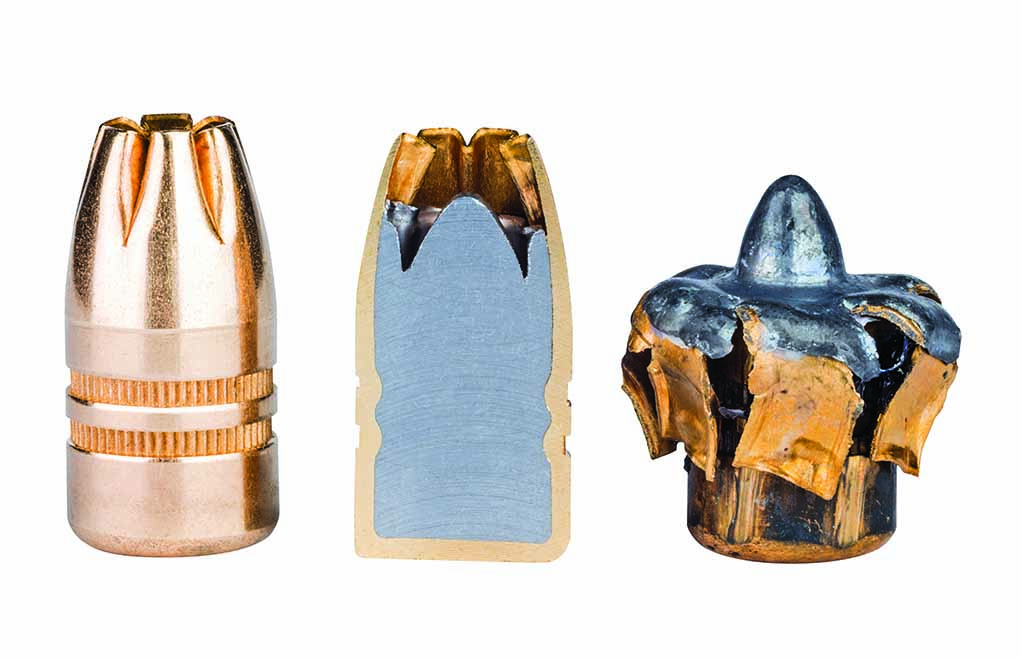
Lead-free monometal bullets are another relatively new design. It offers a unique set of benefits and issues, as we’ll see momentarily. Randy Brooks of Barnes Bullets was a big innovator of the all-copper design, and his concept has translated to the pistol bullets.
The selection of handgun bullets is wide and diverse, but I’d like to take a look at some of the most popular designs and compare and contrast the features and benefits of them. Within this comparison, I’ll look at the Federal HST, Hydra-Shok and Hydra-Shok Deep; Hornady XTP and FTX; Speer Gold Dot and Gold Dot G2; Winchester Defender; and the Sierra V-Crown—as loaded in the Sig Sauer ammunition line. All are premium bullets, and all have excellent reputations.
Bullet Similarities And Differences
Comparing bullet performance is a difficult task, because no two situations are exactly alike, and when it comes to a personal-defense bullet, the opportunities for real-world testing are very few (for obvious reasons). As with dangerous-game bullets, theoretical testing doesn’t always equate to reality, but it’s one means of comparison. And, although certain protocols have been set up for law enforcement, what we’re looking at here are personal-defense bullets—our concern is to get out of a deadly situation, not pursue the aggressor.
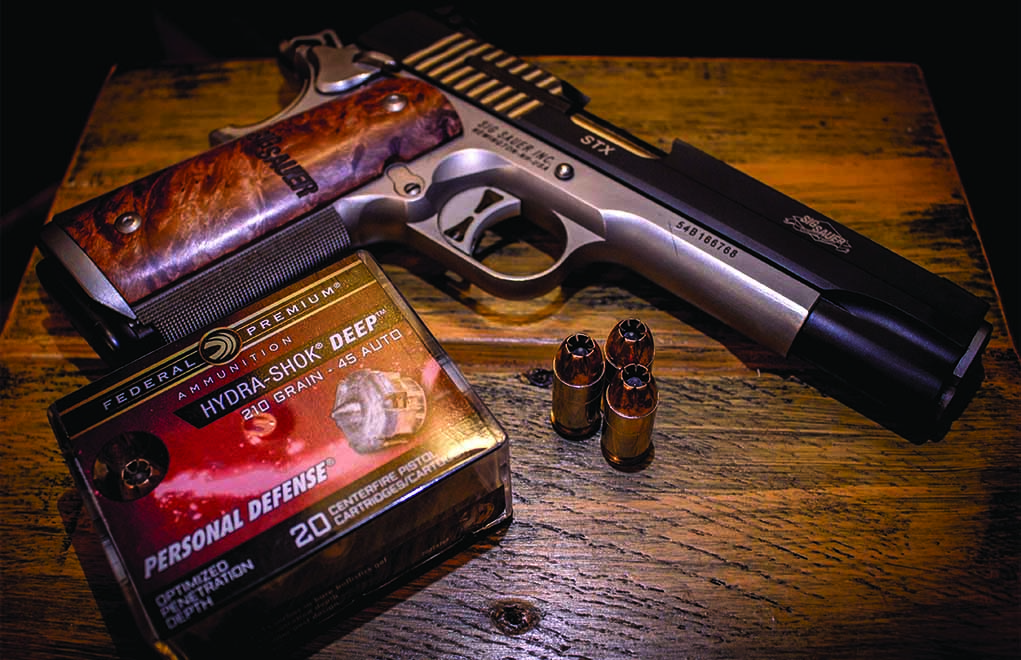
All these bullets, with the exception of the Hornady FTX and the Speer Gold Dot G2, are hollow-points, and all use a lead core and copper jacket. The Winchester Defender, Speer Gold Dot and Gold Dot G2 are all bonded-core designs. The other bullets are cup-and-core.
Federal Hydra-Shok
Starting with the famous Hydra-Shok—which was the “flagship” of Federal’s handgun “fleet” for decades—we’re looking at the bullet that has been the darling of both law enforcement and the personal-defense community. This is an excellent design by ballistic engineer Tom Burczynski, and it represents a definite advancement in bullet design. Using a skived jacket and unique center post at the base of the hollow cavity, the Hydra-Shok gives good expansion, although I’ve seen the bullet “plug up” in heavy clothing and fail to expand. Still, the Hydra-Shok has a solid reputation.
Federal Hydra-Shok Deep
The Hydra-Shok Deep can be considered a modern update of the Hydra-Shok. The engineers took a look at all the good and bad points of the Hydra-Shok and fixed the bad. The revised center post has made a world of difference in post-expansion and penetration; it seems the Hydra-Shok Deep is everything Burczynski intended the first iteration to be. It’s currently available in 9mm Luger, .40 S&W and .45 ACP, and I can see the Hydra-Shok Deep replacing its predecessor in the not-too-distant future.
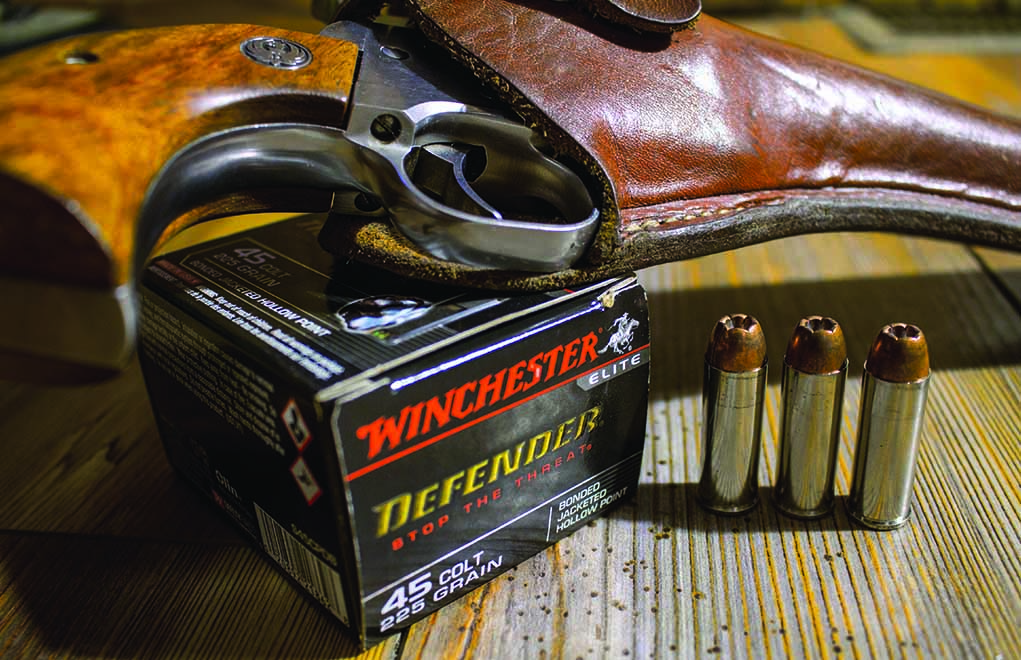
Federal HST
Federal’s HST uses a deep hollow-point, skived jacket and core to give dependable expansion—often twice the caliber—and a core stiff enough to allow the bullet to penetrate to what many consider the optimum depth (right around the 15-inch mark) in both bare gelatin and through heavy clothing. The resulting upset bullet is a wicked-looking piece of gear. The core and jacket are not bonded. Instead, a cannelure is used to mechanically lock the components together.
Hornady XTP
The Hornady XTP is a simple, yet effective, design, covering many different bases. Hornady states that the XTP is applicable for law enforcement, hunting and self-defense alike, and I can’t argue with that assessment. Using a hollow-point design with a copper jacket of varying thickness in order to control expansion, the XTP—and its beefy brother, the XTP Mag.—can be relied upon as a good, traditional choice for most cartridges. It uses a cannelure—in the revolver cartridges—to lock the cup and core together, and the serrations in the jacket at the nose weaken the jacket just enough to promote uniform expansion.
Hornady FTX
The Hornady FTX has its roots in the development of a new bullet for lever-action rifles. Those classic lever guns use a tubular magazine, with the cartridges lined up with the meplat of one projectile touching the primer of the cartridge ahead of it. A spitzer bullet presents the risk of detonating the cartridge ahead of it—with catastrophic results. Hornady changed the game by adding a flexible, rubbery tip—which easily compresses and eliminates any detonation risk. Hornady applied this technology to handgun bullets, filling the hollow-point with that flexible material. This slows expansion, giving deeper penetration, and it also makes the bullet compliant in those places where hollow-point ammunition is illegal.
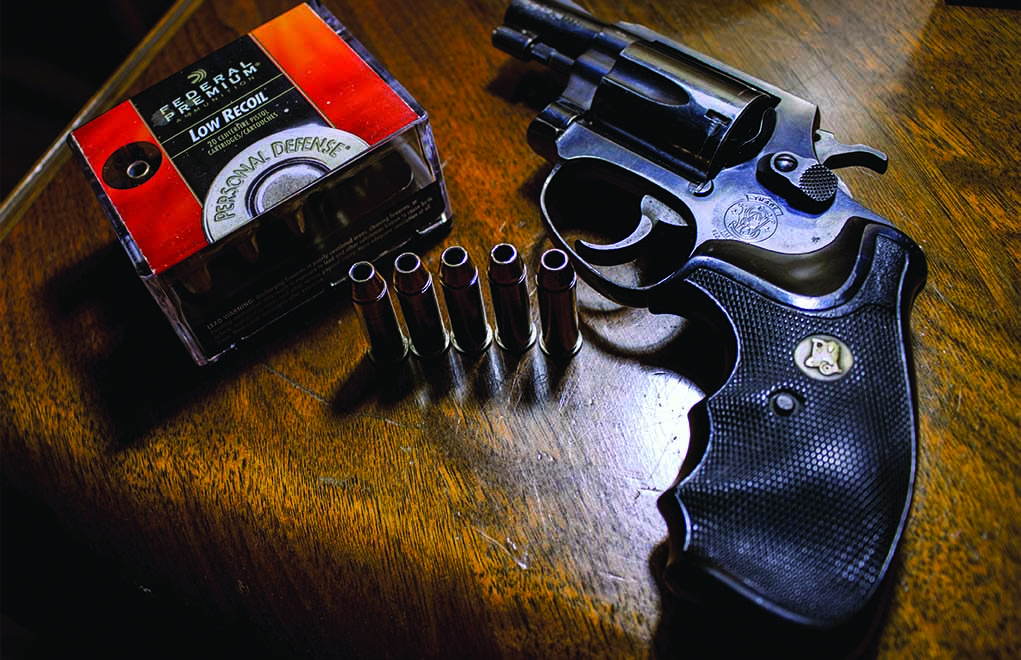
Speer Gold Dot
The Speer Gold Dot is a tried-and-true design, embraced by law enforcement and citizens alike. Using a skived jacket chemically bonded to an alloyed lead core, the Speer Gold Dot has been a winner for years, giving repeatable and dependable results. Speer “tunes” each bullet’s hollow-point geometry to optimize expansion and penetration.
Gold Dot G2
The Gold Dot G2 is a departure from the Gold Dot design. Yes, it uses the same bonding process as the Gold Dot, but instead of a deep hollow-point, it uses a shallow dish at the nose, filled flush with what Speer calls an “elastomer.” Internal fissures—built into the bullet—are forced apart upon impact, resulting in a bullet that has been absolutely stellar in all protocol testing.
Winchester Defender
The Winchester Defender is a bonded design with a notched jacket, designed for a balance of expansion and penetration that will get you out of trouble. Upon impact, the Defender’s nose splits into six pieces for expansion up to 1.5 times the caliber.

Sierra V-Crown
The Sierra V-Crown is available in both component form and is also loaded in the Sig Sauer factory ammunition. Using a unique “stacked hollow-point” design, the V-Crown gives reliable expansion and has proved to be a very accurate bullet (no surprise from Sierra) in all my experiences.
Conclusions
Looking at all these designs, there are a couple that have stood out, because I feel they represent the best all-around balance of accuracy, reliability and recovered shape. Again, please allow me to remind you that a defensive bullet has few opportunities to be tested in a real-world scenario, so I’ve consulted with LEOs for some insight, as well as making my own observations.
As stated before, I’ve seen the Hydra-Shok plug and fail to expand when shooting through denim, but I can see why the Hydra-Shok Deep (the revamp) is going to be a huge success: It works very well in a number of different conditions. I like the Hornady XTP, especially in revolvers, and I often carry my own handloaded ammunition built around this bullet in my Smith & Wesson Model 36 in .38 Special.
I also have a ton of faith in the Speer Gold Dot and feel it could be a serious contender for the best defensive bullet ever designed. The bonded design will hold together under nearly any circumstance, and I’ve yet to see or hear of a Gold Dot that’s failed to expand. I like the accuracy of the Gold Dot, as well as the way it feeds, and I’m not alone. The Gold Dot G2 is going to be a serious contender.
The Hornady FTX—lighter than the FlexLock bullet designed for law enforcement—has shown that in certain circumstances, it will lack penetration. I personally feel better about carrying Hornady’s XTP over the FTX design.
The Sierra V-Crown is definitely a sound design and certainly worth an “audition.” Those stacked cavities equal good expansion; the bullets are plenty accurate; and penetration tests show more-than-adequate performance in bare gelatin, as well as through clothing.
However, the ammo I carry on a daily basis is Federal’s HST. I’ve shot a bunch of this stuff—primarily the 230-grain HST load—from my Sig Sauer 1911. It’s wonderfully accurate, gives near-perfect penetration, and the resulting upset bullet is picture-perfect. It’s relied upon by law enforcement and has aced the varying protocol tests without giving too much penetration.
There are many good designs on the market, and I suggest you carry what makes you feel the most confident … as long as the bullet performs properly. Take the time and make the investment to find what makes you the most confident. In my case, I enjoy the consistent expansion and penetration of the Federal HST.

Next Step: Get your FREE Printable Target Pack
Enhance your shooting precision with our 62 MOA Targets, perfect for rifles and handguns. Crafted in collaboration with Storm Tactical for accuracy and versatility.
Subscribe to the Gun Digest email newsletter and get your downloadable target pack sent straight to your inbox. Stay updated with the latest firearms info in the industry.

![Best Concealed Carry Guns In 2025 [Field Tested] Wilson Combat EDC X9S 1](https://gundigest.com/wp-content/uploads/Wilson-Combat-EDC-X9S-1-324x160.jpg)


![Best 9mm Carbine: Affordable PCCs [Tested] Ruger Carbine Shooting](https://gundigest.com/wp-content/uploads/Ruger-Carbine-Shooting-100x70.jpg)
![Best AR-15: Top Options Available Today [Field Tested] Harrington and Richardson PSA XM177E2 feature](https://gundigest.com/wp-content/uploads/Harrington-and-Richardson-PSA-XM177E2-feature-100x70.jpg)
